
About UsThe Numismatic Bibliomania Society is a non-profit organization promoting numismatic literature. For more information please see our web site at coinbooks.org SubscriptionsThose wishing to become new E-Sylum subscribers (or wishing to Unsubscribe) can go to the following web page link MembershipThere is a membership application available on the web site Membership Application To join, print the application and return it with your check to the address printed on the application. Membership is only $20 to addresses in the U.S., $25 for First Class mail, and $30 elsewhere. For those without web access, write to: David M. Sundman, Treasurer AsylumFor Asylum mailing address changes and other membership questions, contact David at this email address: dsundman@LittletonCoin.com SubmissionsTo submit items for publication in The E-Sylum, just Reply to this message, or write to the Editor at this address: whomren@gmail.com
BUY THE BOOK BEFORE THE COIN |
- WAYNE'S WORDS: THE E-SYLUM APRIL 20, 2014
- KOLBE & FANNING ANNOUNCE LIVE ONLINE BIDDING
- OFFER: BOOK ON COINS OF AMORGOS ISLAND
- ERRORSCOPE MAY-JUNE 2014 ISSUE PUBLISHED
- BOOK REVIEW: U. S. LIBERTY HEAD $20 DOUBLE EAGLES
- BOOK REVIEW: AMERICAN GOLD AND PLATINUM EAGLES
- BOOK REVIEW: PHILIPPINE MEDALS AND TOKENS, 1780-2010
- PODCASTS: EXPLORING THE WORLD OF MONEY
- MORE ON EVERETT JONES
- GOBRECHT PATTERN HUB REDUCTION DISCOVERED
- NUMISMATIC RESEARCH IN PHILATELIC PUBLICATIONS
- PETER BERTRAM ON DAVIS FLIGHT MEDALS
- ROOSEVELT UNIVERSITY NUMISMATICS DIPLOMA
- JOHN BURNS ESTATE UPDATE: APRIL 20, 2014
- UNIQUE ÆTHELBERHT II SILVER PENNY TO BE SOLD
- SOME RECENT COIN DESIGNS: APRIL 20, 2014
- WEB SITE: MEDALLIC ART COLLECTOR
- ROCHESTER PUBLIC MARKET ADOPTS WOODEN TOKENS
- AN UNCLASSIFIED PEEK INSIDE FORT KNOX
- IRON AGE NORFOLK WOLF COINS UNCOVERED
- EXHIBIT: CURIOSITIES FROM THE BANK OF ENGLAND VAULTS
- THE 2014 ROYAL MAUNDY CEREMONY
- BRITISH MUSEUM VIKING COIN EXHIBITION
- NUMISMATIC EXHIBITS ON WORLD WAR I CENTENARY
- MORE ON THE VACHERON CONSTANTIN FABERGE EGG
- THE WORLD'S MOST BEAUTIFUL BOOKSHOPS
- ATMS THAT FIGHT BACK
- FEATURED WEB SITE: MONEY & MEDALS NETWORK
Click here to access the complete archive
To comment or submit articles, reply to whomren@gmail.com
WAYNE'S WORDS: THE E-SYLUM APRIL 20, 2014

Our new subscribers this week include Edward Wright. Welcome aboard! We have 1,718 email subscribers.
This week we open with an announcement from literature dealers Kolbe & Fanning, a free book offer, a new issue of ErrorScope and three book reviews.
Other topics include the new MoneyMuseum/CoinsWeekly podcasts, a Gobrecht pattern hub reduction discovery, the 2014 Royal Maundy ceremony and a report from the corner of Bullion Blvd. and Gold Vault Road.
To learn more about iCollector.com, the Coinage Act of 1873, numismatic research in philatelic publications, Norfolk wolf coins, the coins of Amorgos island, and the Royal Executioner and Lord High Character Assassin of Bermania, read on. Have a great week, everyone!
Wayne Homren
Editor, The E-Sylum
KOLBE & FANNING ANNOUNCE LIVE ONLINE BIDDING
Kolbe & Fanning Numismatic Booksellers have announced that their future sales of numismatic literature will feature live online bidding, beginning with their May 15–16 sales of the Philip W. Ralls library and other important numismatic books. Bidders will be able to participate in each sale online as they would in a live auction, using the custom bidding platform developed for Kolbe & Fanning by the popular online auction service iCollector.com. To see the new Kolbe & Fanning live online bidding site, please go to auction.numislit.com.
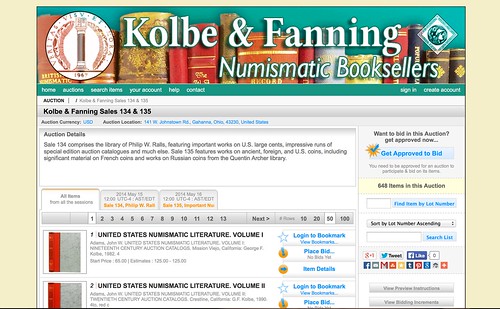
As always, printed catalogues have been issued and have been mailed this week to current customers. Bidders preferring to bid by mail, fax, phone or email may continue to do so, but all such absentee bids must be received by May 14. Every lot is illustrated in the online catalogue, and bidders can tell at a glance where the current bid stands. We think our customers will agree that the new platform represents an improvement over the old mail-bid format.
On May 15, we are privileged to offer the very fine library on American numismatics formed by Philip W. Ralls. Dr. Ralls was a specialist in United States large cents, and his library features important and rarely seen works on this popular subject. Highlights include the deluxe leatherbound editions of both the Newcomb work on 1801–1803 and the Clapp work on 1798–1799. Special edition auction catalogues are also well represented, with outstanding copies of all three deluxe Mehl sales and the rare deluxe Superior catalogues for virtually all of their important large cent sales, most of which were issued in ten copies each. The important set of ANA auction catalogues formed by Ralls is also included.
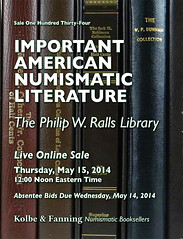
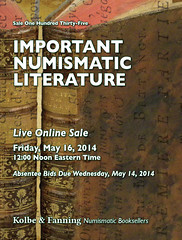
The following day, May 16, will see a second session offered, consisting of important numismatic books from around the world. The section on ancient numismatics features a set of Mazzini’s important work on Roman imperial coins, a copy of Giel’s Antiken Numismatik Südrusslands, a set of the Numismatische Zeitschrift (Wien), de Morgan on Persian coins and other delicacies. Works on medieval and modern foreign coins include material from the important library on Russian numismatics formed by Quentin Archer and a nice group of books on French coins, many in fine bindings. A small but choice section of work on U.S. numismatics includes some rarely seen sale catalogues and periodicals.
The changes in sale format and instructions have necessitated some changes to the Terms of Sale, which prospective bidders are encouraged to read before bidding. As a reminder, all absentee bids must be received by May 14. Absentee bids cannot be accepted on the sale dates. The live online sales will each begin at noon eastern time.
Kolbe & Fanning’s website is www.numislit.com and their live online site can be reached at auction.numislit.com. We look forward to your participation.
OFFER: BOOK ON COINS OF AMORGOS ISLAND
 SIATRAS INTERNATIONAL BOOKSHOP welcomes all collectors and numismatists to see the new titles at its blog:
booksoncoins.blogspot.gr
SIATRAS INTERNATIONAL BOOKSHOP welcomes all collectors and numismatists to see the new titles at its blog:
booksoncoins.blogspot.gr
Every visitor that can afford the shipping cost may have a free copy of the classic treatise of Paulus Lambros on "Amorgos coins", recently translated in English. The offer holds until the release of the next issue of The E-Sylum.
To reserve your copy, contact Demetrius at
demmath@hotmail.com
ERRORSCOPE MAY-JUNE 2014 ISSUE PUBLISHED
The latest issue of Errorscope , CONECA’S (The Combined Organizations of Numismatic Error Collectors of America) bimonthly journal is now at the printers. The May / June issue should be available to members at or around the first of May from the CONECA Errorscope Online Members Only Area (assessable from the banner at the top of the CONECA homepage) and a hard copy should be showing up in mail boxes to all current members at about the same time.
In this issue, Robert Knauss continues his series of “In Search of Standing Liberty Quarter Varieties and Errors” and focuses this article on the 1918/7 – S over date. Mr. Knauss uses several photographs in his article showing some markers of this variety.
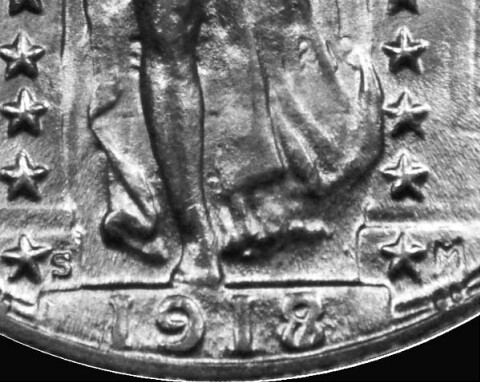
Roger Paulen discusses in his article a doubled die 1967 Canadian Centennial 1 – Cent piece. Mr. Paulen with the assistance of Ken Potter, elaborates on the history of this variety and when Alan Herbert first listed it for Robert Wilharm.
The 1995-D Lincoln One Cent DDO-003 is highlighted in this issue, along with several others varieties, courtesy of James Wiles, CONECA 20th / 21st Century Die Variety attributor.
Joe Rizdy writes an interesting article on the 1859 Canadian One Cent struck on a brass planchet and a 1881 Canadian One Cent piece showing some doubling in the word VICTORIA.
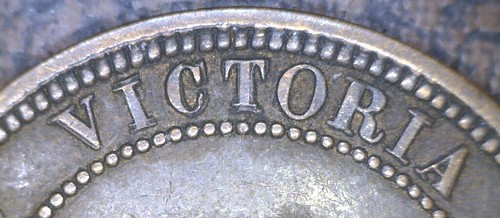
Jon Sullivan gives us a show report on the 59th Annual Winter FUN Show held in Orlando, Florida. One of coins featured in Mr. Sullivan’s article is a 1911 Lincoln cent double-strike off center that Rich Schemmer had in one of his cases.
Joseph Ceravone discusses what is involved in setting up a table as a CONECA State Representative at a coin show. Mr. Ceravone’s suggested blueprint makes it sound so easy that the rewards will definitely outweigh the effort, what better way to see and study different die varieties and errors. If you are interested in becoming a State Representative in your area, please contact James Motley at jmotley@alpinecomputers.net
Anybody wanting to join CONECA should contact Rachel Irish at 101 West Prairie Center #323, Hayden, ID 83835 or email MRirish5@roadrunner.com A copy of the application form may be download at http://conecaonline.org/content/join.html. Annual dues are as follows: Adult Member $25.00 per year, Young Numismatist (online Errorscope only) $7.50 per year or (online Errorscope plus mailed hard copy) $17.50.
CONECA members wishing to receive a login username and password to access the Errorscope Online Members Only area, please email the Membership Coordinator, Rachel Irish at the address listed above. A valid email address on file with CONECA is required for access to current and back issues of the Errorscope online.
THE BOOK BAZARRE
BOOK REVIEW: U. S. LIBERTY HEAD $20 DOUBLE EAGLES
 U. S. Liberty Head $20 Double Eagles, The Gilded Age of Coinage, By: Q. David Bowers, with Robert Galiette, 2014, Published by Stack’s Bowers Galleries, Reviewed by John and Nancy Wilson
U. S. Liberty Head $20 Double Eagles, The Gilded Age of Coinage, By: Q. David Bowers, with Robert Galiette, 2014, Published by Stack’s Bowers Galleries, Reviewed by John and Nancy Wilson
The U.S. Liberty Head $20 Double Eagles, The Gilded Age of Coinage is a hardbound reference with 376 pages. It has 60 Chapters covering the 60-year period from the discovery of gold in California in 1848 to 1907. Interspersed throughout the book you will find hundreds of photographs and illustrations in color and black and white. The Foreword by Mr. Galiette talks about the importance of this sixty year period in our young country. The Introduction by Mr. Bowers gives you a synopsis of what you will find in the following chapters.
This book covers most of the financial events which occurred in the United States during that 60 year period. It also gives interesting tidbits of information relating to life in America during that time. The interests and fads during that period are also described. In 1858 numismatics became popular. The numismatic related events such as the paper money issued by both the North and South are discussed. Large photographs of most of the finest double eagles by date are shown. The other moneys of the period are also shown in their context in history.
The authors cover an interesting period of U. S. financial history which we had never heard of before reading this book. It is the 1869 speculation which resulted in the first “Black Friday.” It seems that speculators, Jay Gould, James Fisk and President Grant’s brother-in-law Abel Corbin, attempted to corner the available supply of gold and drive up its value. Instead of that happening the Secretary of the Treasury, George Boutwell, entered the market and sold gold held by the government. The price fell and the speculators lost many tens of millions of dollars which they never paid back.
Surprisingly, much of the corruption which occurred in the U.S. during these years is explained in detail. We have never seen much of this information in any of our reading covering this period. The Credit Mobilier scandal uncovered during the 1872 election showed how the railroads hired this company to build the rail lines across American and bill the railroads at inflated prices, to which the railroads added a “management fee” and then submitted the invoices to the government for payment.
It also explains how the Coinage Act of 1873, which we are all familiar with, was affected by the panic of 1873 which was the result of too much debt because of the cost of railroad construction in the preceding five years. For great information on the Credit Mobilier go to this site: www.history.com/topics/credit-mobilier
This book explains the numismatic events of the period from an economic perspective we normally do not hear about. Both Q. David Bowers and his associate, Robert Galiette has a very interesting way of presenting this information which makes the reasons for the numismatic events so logical in economic terms.
The causes of the financial panic of 1893 which lead to the collapse of the stock market in June of that year were explained in detail. 1893 also was the year the Columbian Exposition opened in Chicago. It is probable that the lack of sales of numismatic items at the fair could be traced to the financial panic and depression of 1893 which continued into 1894. 1893 was also the year that Augustus G. Heaton’s book on branch mint coins was published. Until that time collectors only concerned themselves with the date on the coin and ignored the mint completely. He made the case for collecting coins by mint as well as by date.
The gold double eagle was the main gold coin in the government’s hoard used to back up the huge amount of paper money it had issued. This hoard was increased in 1899 by the gold streaming in from Cripple Creek, the Klondike and the large number of double eagles returning from Europe.
The authors noted some of the large collections being formed at the time including the Brand and Garrett collections. The parallels between economics and numismatics have never been made clearer.
The “Epilogue” by Mr. Galiette talks about the transition from the $20 Liberty Head to the Saint-Gaudens $20 and a lot more. Elections, Wars, Coinage Productions, The Gold Reserve Act, Laws Coinage, Collectors and their Collections, Survival Rates of Double Eagles and lots more. This book is very interesting and presents numismatics from a new perspective.
The authors talk about “Follow the Money” as it pertains to the Double Eagle and the in-depth economic history during this sixty year period. We recommend that you “spend a little money” and buy this fascinating and interesting reference that covers a subject in a manner that would be of interest to dealers, collectors, investors and anyone else interested in our economic history.
Anyone reading this review before May 1, 2014 can order an early preview copy for $35 by contacting Jen Meers at jMeers@stacksbowers.com or by phone at (866) 811-1804 or by mail at, StacksBowers, P. O. Box 1804, Wolfeboro, NH 03894.
BOOK REVIEW: AMERICAN GOLD AND PLATINUM EAGLES
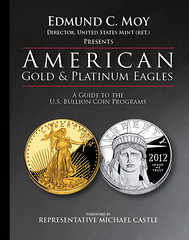 Whitman Publishing, LLC has published another in-depth and behind-the-scenes book that covers American Gold and Platinum Eagles: a Guide to the U.S. Bullion Coin Programs, and is authored by retired director of the United States Mint, Edmund C. Moy. American Gold Eagle bullion coins have been produced by the United States Mint since 1986. Production of American Platinum Eagle bullion coins began in 1997. Both of these coins are extremely popular with collectors and investors. Moy was director of the U.S. mint from 2006 until 2011 and shares his unique insight and perspective on these highly collectible coins.
Whitman Publishing, LLC has published another in-depth and behind-the-scenes book that covers American Gold and Platinum Eagles: a Guide to the U.S. Bullion Coin Programs, and is authored by retired director of the United States Mint, Edmund C. Moy. American Gold Eagle bullion coins have been produced by the United States Mint since 1986. Production of American Platinum Eagle bullion coins began in 1997. Both of these coins are extremely popular with collectors and investors. Moy was director of the U.S. mint from 2006 until 2011 and shares his unique insight and perspective on these highly collectible coins.
Moy directed the Mint during a turbulent period of unprecedented growth. Sales of silver, gold and platinum skyrocketed during the "Crash of 2008" and the "Great Recession" that followed. He begins the book by taking you on a pictorial and descriptive tour of his tenure at the Mint. A personal touch is added to the book with private pictures that includes his family members as well as Treasury Secretary Hank Paulson. He also recollected details of staff meetings and cabinet meetings that he attended.
The second chapter of the book begins with a primer on investing in bullion coins. To truly understand what one is getting into with bullion coins, they must understand some of the history that has gone before them. This chapter covers everything from ancient coins through modern investment vehicles such as allocated and unallocated holdings. One of the most fascinating sections in this book is What Are the Forces Driving the Price of Gold? This behind-the-scenes look into the Mint's research into predicting the price of gold will make this book one of the most valuable items in your numismatic library.
Moy also brings together a variety of elements that are artistic as well as technical, some steeped in history and others driven by the latest news headlines. Collectors as well as investors will find great value in purchasing this book. "Just counting the 1-ounce American Gold Eagles, collectors and investors have purchased more than 15 million coins since 1986," said Whitman publisher Dennis Tucker. "Add to that millions of the smaller fractional-ounce gold coins, and the Mint's Proofs and other collector formats, plus the platinum series with its historical designs, and you have more than 42.5 million coins sold. American Gold and Platinum Eagles is the world's first book length study of these popular coins."
The meat of the book begins in Chapter 5 - Year-By-Year Study of American Gold and Platinum Eagles. Beginning with 1986 and ending in 2013, a detailed analysis of each year is presented. The background and historical events that happened in that year are followed by a coin commentary that brings out specific events and situations that impacted production of gold and platinum bullion coins that year.
Finally, for each type of coin, estimated values, specifications and mintage data are given. Several appendices in the back of the book contained information such as: Summary tables of American Gold and Platinum Eagle mintages, general information on the Silver and Palladium Bullion Programs, American Buffalo and First Spouse Gold Bullion Coins, the 2009 Ultra High Relief Gold Coin, background information on the designer of the Gold American Eagle reverse, and an illustrated catalogue of coins produced during the tenure of Edmund C. Moy.
Hardcover: 224 pages
Publisher: Whitman Publishing (December 3, 2013)
Language: English
ISBN-10: 0794839738
ISBN-13: 978-0794839734
Product Dimensions: 11 x 8.6 x 0.7 inches
To read the complete article, see: Book Review: American Gold and Platinum Eagles (coins.about.com/od/Coin-Books-And-Publications/fl/Book-Review-American-Gold-and-Platinum-Eagles.htm)
BOOK REVIEW: PHILIPPINE MEDALS AND TOKENS, 1780-2010
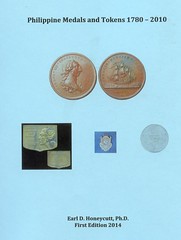 PHILIPPINE MEDALS AND TOKENS, 1780-2010
PHILIPPINE MEDALS AND TOKENS, 1780-2010
By Earl D. Honeycutt Ph.D.
Mactanboy Press, Chapel Hill N.C. 2014
Reviewed by David Thomason Alexander, April 2014
The publication of Philippine Medals and Tokens, 1780-2010, by Earl D. Honeycutt Ph.D. (Mactanboy Press, Chapel Hill N.C. 2014, spiral-bound, 136 pages) is a major event for collectors in a long-neglected area. Interest in Philippine numismatics in the U.S. has developed slowly. Despite some 40 years of American rule in the islands, there has been surprisingly little spill-over interest from collectors of American coins.
While Philippine coins have been largely overlooked, although listed in recent years in the Guide Book of United States Coins (the “Red Book’), medals and tokens have been virtually ignored. There has never been a truly definitive catalogue of Philippine medals, though they were at least touched upon in two of the most important early books on Philippine numismatics: Neil Shafer’s United States Territorial Coinage for the Philippine Islands (Whitman, 1961); and Aldo P. Basso’s Coins, Medals and Tokens of the Philippines 1728-1974 (Bookman Printing, Manila, 1968, 1972).
Both Shafer and Basso listed such medals as were known to them, although Basso listed a far greater number of types without providing much elaboration on why the medals listed came into existence and without making any real effort to tell their stories however briefly.
This reviewer is himself a long-time student of Philippine medals, whose contributions to numismatic periodicals include “Kalayaan, Kapayapaan, Katarungan, Wartime Medals of Jose Paciano Laurel” (Numismatic Scrapbook, December 1975. pp 26-36; “Philippine Republic Medals of World War II,” The Numismatist, May 1988, pp 825-835) and most recently “Collaboration and Conflict: the 1949 Philippine Presidential Election,” ANS Magazine, 2013 Issue 2, pp 36-47. The last article drew upon the great Gilbert S. Pérez Collection donated to American Numismatic Society by the collector’s daughter Eleanor Pérez Niles.
According to his book, cataloguer Honeycutt grew up in North Carolina. He served in Vietnam in the U.S. Air Force and was stationed at several important facilities in the Philippines. Later study brought him graduate degrees in Asian Studies, History and Business Administration. He began in-depth collecting of Philippine material while actually living in the Philippines! A delightful note is provided in his introduction by references to his travel, coin buying and enjoying “cold San Miguel beer!”
The first edition is profusely illustrated, with many images drawn from the Basso books. If budget permits, future editions could be immeasurably improved by upgrading image quality. Of course, the impressive cost of digital photography and printing today must be understood as determining factors not easily overlooked.
First editions of books with the broad scope of hilippine Medals and Tokens 1780-2010 will inevitably omit some items but hopefully will stimulate readers to bring such treasures to the cataloguer’s attention. The listings of medals from the Spanish colonial period and the era of American rule are extensive with few new additions.
There are a few areas where descriptions should be updated in any new edition to reflect recent research, notably medals of the Second Philippine Republic portraying President José Paciano Laurel. Honeycutt lists these in Shafer-Basso order, but the Philippine Executive Commission Medal (Honeycutt 322, Basso 166) should precede H.321 as it commemorates an earlier governing organ out of which the Second Republic evolved.
The pejorative term “puppet” is seriously obsolete and interferes with dispassionate study of history. With apologies to Shafer and Basso, it must be pointed out that neither Laurel nor Jorge Vargas “were apprehended after WWII ended,” but both voluntarily presented themselves to American forces early in the invasion of Japan.
In fact, they and the overwhelming majority of the 5,000-plus Filipinos initially charged with collaboration were never convicted of any treasonable offense. Laurel went on to nearly win the Presidency in the stormy and corrupt 1949 election. His portrait hangs today in Malacañang Palace identified as “President Laurel” and his bust and Great Seal of his 1943 republic graced the republic’s 1991 copper-nickel 2 piso coin of 1991.
One of the book’s greatest values is its inclusion of many medals issued since the late Marcos era, most of which are unknown to American collectors. Many are particularly fascinating as reminders of the “People Power” revolution and succeeding presidencies.
Honeycutt’s updating of catalogue values is courageous and a major service to collectors. Pricing often generates controversy but the author has made a praiseworthy effort in this sensitive area that will be of great service to collectors.
One area crying out for expansion is the list of references on page 134. The absence of the Neil Shafer catalogue is incomprehensible. The periodical articles noted above deserve listing, and general Philippine historical books should include David Joel Steinberg, Philippine Collaboration in World War II, University of Michigan Press, 1967, reissued by Solidaridad Publishing House, Manila.
Overall Earl D. Honeycutt deserves the hearty thanks of numismatists everywhere for this extraordinary effort. With the suggestions he is certain to receive about the first edition, one can hope for an enlarged second edition in the not-too-distant future.
Philippine Medals and Tokens, 1780-2010 may be ordered from Earl D. Honeycutt. 226 Edgewater Circle, Chapel Hill, N.C. 27516. Price in hard cover is $75 per copy plus $3 for shipping and handling; soft cover $50 plus $3 for shipping and handling; also offering the new book is Ray Czahor, Cookie Jar Collectibles, P.O. Box 428, Savage, MD 20763-0428.
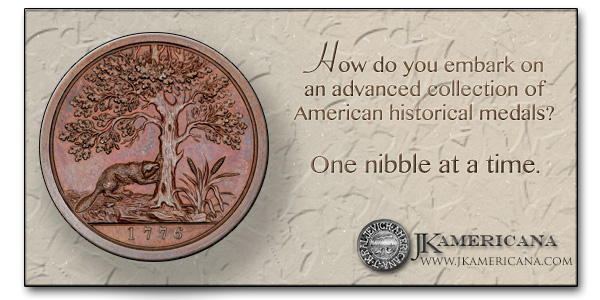
PODCASTS: EXPLORING THE WORLD OF MONEY

Exploring the World of Money – a collaboration between MoneyMuseum and CoinsWeekly
As of 1 March 2014, the MoneyMuseum provides podcasts and other documents related to money in all its facets on the internationally renowned platform ‘iTunes U’ to all interested parties. The range covers numismatic journeys as well as a test on one’s own relationship to coins and bank notes. Profound knowledge about the world of money is conveyed, yet in an entertaining and enjoyable way. Heidi Lehner, Manager of the Sunflower Foundation as provider of the MoneyMuseum, emphasizes: “We deem it important to challenge prejudices with our contributions and to start to think about alternatives.”
Exploring the World of Money
The section ‘Exploring the World of Money’ is very likely to be the most fascinating to the coin aficionado. Here, a new coin, a new bank note, a new numismatic object is introduced every two weeks. A five-minute podcast sheds light on the historical-cultural backdrop and explains both images and meaning. From the very first coin to the dollar note, from pre-monetary money to Bitcoins, from piggy-banks to documents and works of art – everything suitable to illustrate the world of money can be found here. And the stories from the past telling of inflation and insolvency, about investors and yield, about ruthless power seekers, desperate politicians being at a loss, but also about prudent monetary economy, gain in meaning and importance against the background of recent events.
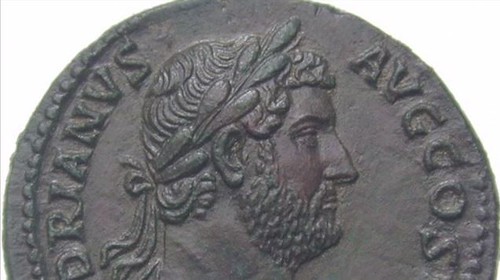
Platform iTunes U
To reach as broad a public as possible, Dr Jürg Conzett, Founder of the MoneyMuseum, has decided to offer his podcasts to be downloaded for free on iTunes U. This platform that was established in 2007 has found many supports, particularly amongst pupils and students for there are much up-to-date, scientifically edited information available there, on almost every subject. By now, more than 300 million downloads are offered every year.
The MoneyMuseum is amongst the roughly 1,000 registered institutions that compete for the learner’s attention. Nevertheless, Dr Jürg Conzett reckons that his offer will have a good chance: “We are the first to use iTunes U for a concrete analysis of money, monetary history and psychology of money. Anyone who wants to get information on money’s past, present and future virtually has no alternative to our offer. Plus, we provide all of our podcasts in German-English. Hence, we are able to reach both the German-speaking area, which is somewhat undersupplied with iTunes U, and the international audience.”
MoneyMuseum@CoinsWeekly
To accommodate those who do not (want to) have an iTunes account, MoneyMuseum now collaborates with CoinsWeekly. The free journal that is updated on a weekly basis now provides its readers with the opportunity to view all movies of the MoneyMuseum on the internet, by accessing them at its site quite easily. After just one click, the movie already starts.
Finally, let’s talk technology
For downloading the MoneyMuseum podcasts from iTunes U, you may first get the necessary software / apps at the following links:
iTunes for Mac and PC: https://www.apple.com/itunes/download/
iTunes U App for iPhone: https://itunes.apple.com/ch/app/itunes-u/id490217893?mt=8
iTunes U App for iPad: https://itunes.apple.com/ch/app/itunes-u/id490217893?mt=8
TuneSpace for Android: https://play.google.com/store/apps/details?id=de.twokit.tunespace
The new site of the MoneyMuseum you will find at
http://muenzenwoche.de/de/MoneyMuseumMuenzenWoche/36
The website of the MoneyMuseum with all podcasts available as well you find at
http://sunflower.ch/de/moneymuseum/museum
MORE ON EVERETT JONES
Howard Daniel writes:
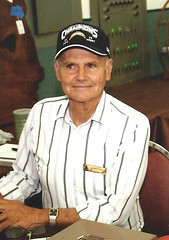 Sometime long ago when I was regularly writing for World Coin News, I wrote about chopmarked coins several times. After one of those articles, I received an email or letter from Everett Jones telling me about the Chopmarked Collectors Club. I immediately joined and Everett and I regularly corresponded about chopmarked coins I found in my Southeast Asian travels.
Sometime long ago when I was regularly writing for World Coin News, I wrote about chopmarked coins several times. After one of those articles, I received an email or letter from Everett Jones telling me about the Chopmarked Collectors Club. I immediately joined and Everett and I regularly corresponded about chopmarked coins I found in my Southeast Asian travels.
When the American Numismatic Association planned a convention in Los Angeles, I contacted Everett and asked if he would meet with me at it. One thing led to another and I "shanghaied" him to be the speaker for my Numismatic International (NI) meeting at the show. We met when the show opened and I asked him to sit behind my club table for IBNS, NI and several other organizations. We talked and talked for many hours.
I had publicized his being the speaker at the NI meeting but I did not expect the crowd that came into the room! It was the largest number of attendees I have ever had at an NI meeting! And there were dealers in the crowd who had closed down their tables for his talk! He talked about the history of chopmarked coins, and he brought examples of many different rare pieces. The audience brought many pieces to show him and they also asked many questions. We went by our time limit in the room but luckily there was not another meeting's attendees pushing us out of the room. The meeting went on and on until I finally saw Everett was getting tired, so I closed it down.
The current editor of the Chopmarked Collectors Club newsletter Chopmark News, is now Colin Gullberg. He lives in Taiwan and he has built on Everett's work. Colin can be contacted at ChopmarkNews@gmail.com if you want to receive the newsletter and/or join the club. I think anyone will be challenged in collecting chopped coins (and notes too!).
To read the earlier E-Sylum article, see: EVERETT JONES, 1933 - 2014 (www.coinbooks.org/esylum_v17n16a08.html)
THE BOOK BAZARRE
GOBRECHT PATTERN HUB REDUCTION DISCOVERED
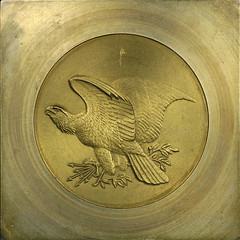
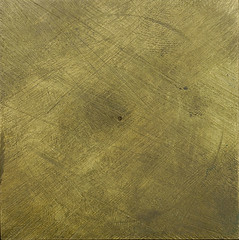
Front and Back
Numismatic Guaranty Corporation (NGC) has authenticated a previously unreported brass hub reduction produced at the United States Mint from an eagle designed by famed US Mint Engraver Christian Gobrecht. A hub reduction represents a transitional piece between the sculpted model and the hub used to create coining dies.
This square piece came to NGC in a most unusual manner. NGC grader John Schuch was an instructor at last year’s American Numismatic Association Summer Seminar, and among his students was Alexandrea Zieman.
She told John that her father, John Zieman, Jr., owned an unidentified brass plate bearing an eagle that they believed to be of US Mint origin. Alexandrea asked John to meet with her and her father at the Summer Fun Convention in Orlando just a few weeks later, and it was then that the item was submitted to NGC for authentication and grading.
All that was known initially about the brass trial is that within its square was a hub image of silver dollar size depicting a Gobrecht eagle not known to have been used with any dollar patterns. This same device, however, had been reduced to half dollar size for use on silver and copper half dollar patterns dated 1838.
These are varieties Judd-80 and -81, respectively. That die marriage combined the Seated Liberty No Drapery figure adopted for circulation the following year with a defiant eagle soaring upward, grasping a bundle of arrows in one claw and an olive branch in the other. This eagle die was not used with any other pattern strikings, and it is not known for any denomination other than the half dollar.
To determine the authenticity of this unusual piece NGC sought out the most extensive collection of Gobrecht sketches and trial strikes—that held by the Smithsonian Institution’s National Numismatic Collection. There, coin dealer, researcher and NGC consultant Jeff Garrett took photos of a hub trial and a die trial, both in brass, of the same eagle device. The only difference in design from the new specimen is that both of the Smithsonian’s trials had been reduced to half dollar size and were thus associated with the two known patterns, Judd-80 and -81.
There were no dollar size impressions of this eagle device. The Smithsonian pieces are illustrated in Elvira Clain-Stefanelli’s article “From the Drawing Board of a Coin-Engraver: Sketches by Christian Gobrecht for the Coinage of 1836-1839,” published in the American Numismatic Association Anthology in 1991. Also seen in this article are extremely similar sketches in Gobrecht’s hand of this eagle image, which was designed by artist Titian Peale.
Owner John Zieman, Jr. provided NGC with some background on how he came to obtain this hub reduction:
“In May 2012 a local picker/estate liquidator bought out an estate in Homosassa, Fl. The home owner is believed to be 7th generation Patterson. The people who inherited it sold all contents to this picker.
My good friend and a long time picker had an idea of what was there. He also heard lots of stuff already was thrown away before he bought it. After buying the items he knew Alexandrea and I collect coins, early American items, mint items, etc. so he brought them to me.
I made several deals to buy a majority of the items he got. I received items starting in late 2012 through present. Our goal (Alex and me) is to keep these items together and let others see and learn from them.”
Indeed, this item is accompanied by an extensive assortment of objects and documents obviously from the estate of Robert M. Patterson, Director of the Mint from 1835 to 1851. These include an engraved portrait believed to be that of Mr. Patterson’s father and the copper plate from which it was taken, a ring and several honorary certificates. Perhaps of most interest to numismatists is a letter from Chief Coiner Adam Eckfeldt to R. M. Patterson dated September 1, 1829 and reading as follows:
The present private opportunity enables me to comply with my first intention of asking your acceptance of two specimens of the smallest coin of the United States.
The issue having been made on the 4th of July 1829, it being the first of a new design, there having been very few struck on this day, are circumstances which together with our long acquaintance, friendly enter change [sic] of good feeling & interesting civilities form strong inducements to the affectionate.
At the time of this presentation, Patterson was still six years away from being employed with the Mint, though he was no stranger to the institution. His father, Robert Patterson, had been Mint Director from 1806 until his death in 1824. The elder Patterson’s successor was Samuel Moore (1824-35), who also happened to be the younger Patterson’s brother-in-law. The US Mint was very much a family business during its first century.
NGC has certified the newly-discovered hub reduction as NGC MS 65. Its composition is 64.5% copper and 34.7% zinc, with a few trace elements. The weight of this specimen is 74.1 grams. It measures 51mm across its flats, and the disc portion has the normal 38.1mm diameter of a silver dollar.
To read the complete article, see: NGC Authenticates Newly Reported Gobrecht Brass Hub Reduction (www.coinweek.com/featured-news/ngc-authenticates-newly-reported-gobrecht-brass-hub-reduction/)
NUMISMATIC RESEARCH IN PHILATELIC PUBLICATIONS
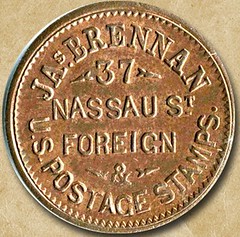 Among the pleasant things on my plate is helping John Ostendorf and the Civil War Token Society with the preparation of the 3rd edition of United States Civil War Store Cards. The 2nd edition was published in 1975, nearly two generations ago, and much has been discovered or modified since. The new version, due out later this year, will include more listings, illustrations in full color, biographical notes on the well over 1,000 different merchants who issued such tokens, and more. Attributions are to Fuld numbers as created by Melvin and George Fuld in the early 1960s.
Among the pleasant things on my plate is helping John Ostendorf and the Civil War Token Society with the preparation of the 3rd edition of United States Civil War Store Cards. The 2nd edition was published in 1975, nearly two generations ago, and much has been discovered or modified since. The new version, due out later this year, will include more listings, illustrations in full color, biographical notes on the well over 1,000 different merchants who issued such tokens, and more. Attributions are to Fuld numbers as created by Melvin and George Fuld in the early 1960s.
Among the New York City issuers was James Brennan, a stamp dealer who held forth at 37 Nassau Street. The Fuld number for Brennan is NY-630-I followed by a number indicating the variety within this listing, plus a letter indicating the metal of striking. In the case of the illustrated token NY-630-I-1a, the a refers to copper. Brennan was the only stamp dealer who issued a Civil War token. In contrast several coin dealers issued such pieces.
The December 1, 1863, issue of The Stamp Collector’s Magazine (the first issue of which was published in London in February 1863) included this advertisement: “James Brennan, 37 Nassau Street (opposite Post Office) New York, United States, has always on hand a large stock of foreign and American stamps, used and unused. Orders promptly executed. Stamps exchanged.”
Seeking more information I found a copy of The London Philatelist, May 1904, on the Internet. It mentions Brennan and also, in passing, A.C. Kline (whose numismatic biography has been published by Dr. Joel J. Orosz). This account suggests that “our” Brennan was America’s first stamp dealer with an office. Wonder if that is true? An excerpt:
I recently received some interesting reminiscences from Mr. Samuel Allan Taylor, Boston, the doyen of American philatelic dealers and editors. I find his advertisements in the Boy’s Own Magazine for 1863, and I have before me vol. i. (the late Mr. Tiffany's copy) of his Stamp Collector’s Record, begun at Montreal in February, 1864, and continued at Albany and Boston. Referring to Judge Suppantschitsch’s supposed discovery, Mr. Taylor writes :—
“I do not think that any German, Frenchman, Swede, Russian, Turk, or Southern European heathen of any kind is entitled to more than a smile of pity from Englishmen when he attempts to discover anything concerned with Philately or anything else in English printed literature. . . . The earliest notice in print on this side is, as far as I have ever seen, a paragraph in November, 1860, which states that youngsters were collecting the stamps of different nations. This appeared in a monthly periodical called Littell's Living Age, published here in Boston. When the Civil War broke out in 1861, the Rebel States quickly issued stamps for themselves—special ones first like Mobile, New Orleans, Nashville, etc. These were counterfeited by a Philadelphia firm, and were reproduced in sheets of six (i.e. six of a kind) and sold by newsboys in the street and in stationers’ stores, not at all as philatelic treasures, but as curiosities of the Rebels. They sold some half dozen sheets for 10c. The words ‘Facsimile Rebel Postage Stamp, printed by S. C. Upham, Philadelphia,’ were printed in small type on each sheet. This thing was largely instrumental in bringing stamp-collecting into vogue.
The first person who sold stamps as a business was a man named James Brennan, who opened a small office (a very small place, not over 10 feet square) at 37 Nassau Street, New York, in 1863. He published a list, the type, style, size, etc., having been copied from one printed by James Robinson, of Liverpool. This was a foolscap size, 4 pp. thing, but the prices were filled in with the pen.
Before that one A.C. Kline, now dead, of Philadelphia, had issued a ‘Manual,’ a copy of Mount Brown’s first issue merely. Kline was a dealer in antiques, old coins, armour, firearms, etc., and stamps were only a small portion of his business. He kept a quite good-sized store on the ground floor.
Another person, Wm. P. Brown, 212, Broadway, New York, who is still in existence, and who then, as now, was more of a coin dealer and authority than a stamp man, sold stamps, but only through the medium of the mail, not having any office, he being a printer in a weekly newspaper office (of which his father, a distinguished clergyman, was editor). I believe that for some time he had a stand attached to the railing of the City Hall Park, as also had another man named John Bailey, but the business was largely coins and odd things, even military buttons. No one then knew what stamps existed, until the manuals of Mount Brown, Baillieu, Potiquet, and others appeared. This was all in New York, of course. J.W. Scott, who is a native of London, came to New York in 1863, he being then a lad of fifteen years. He came across Brown at his stand and made exchanges in stamps with him, but shortly after left New York and went to California.
I was in Montreal from 1860 to 1864. I had gathered some ten or a dozen foreign stamps as far back as 1857-8, France, England, and one 10 gr. Hanover; but I never saw or heard of any collectors until 1862, when I chanced to see the collection (probably forty or so) of a man named A. Nutter, and I made exchanges with him for local stamps, as I (having been brought up in New York) knew where the local stamps or posts were. I left Canada in 1864, and after a short time abandoned the druggist business and came to Boston, and have been here ever since. J.W. Scott I never heard of until 1867; the previous account of him I got from W.P. Brown. You can depend on it that no other dealer was earlier than James Brennan in 1863…
To read the complete article, see:
Tracking Down James Brennan: One Thing Leads to Another
(www.stacksbowers.com/NewsMedia/Blogs/TabId/780/
ArtMID/2678/ArticleID/64463/Tracking-down-James-Brennan
-One-thing-leads-to-another.aspx)
PETER BERTRAM ON DAVIS FLIGHT MEDALS
I feel I must begin by saying that I hold Alan Weinberg in very high esteem and greatly respect his knowledge and experience. Also, this is one of the few opportunities I’ll have to publicly thank him for his generous permission to include the Davis Flight Medal images from his fabulous collection in my forthcoming book. It is with regret, therefore, that I must respectfully disagree with his comments in last week’s E-Sylum.
First off, no dispute with his opening comment. He does indeed have the most impressive collection of coins with Confederate engravings on them that I’ve ever seen!
But then he notes: “All of the specimens in my collection….were hand-engraved by the same skilled artisan whom, it may be reasonably assumed, was camped outside of the Greensboro surrender like a Sutler, and engraved departing Confederate soldiers' take-home pay coins for a small price”; and in the next paragraph: “all mine and most others seen are all engraved by the same hand (easily discerned) and all very specifically dated down to the day - the 25 or 26th”.
For purposes of the discussion at hand, we are only interested in documenting the Davis Flight medals. Unless he has acquired additional specimens, four of Mr. Weinberg’s Confederate engraved coins fit this criteria and they are from the surrender of Gen. Johnston’s Army in North Carolina.
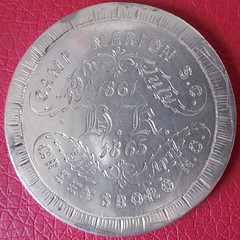 At the time the Army was scattered, specifically: Stewart’s and S.D. Lee’s Corps in the vicinity of Greensboro - D.H. Hill’s and Brown’s Divisions in the vicinity of High Point – and other scattered small contingents spread over a wide area, Salisbury, Catawba, etc, etc. The payout was not quite $38,000 paid to some 32,000 soldiers present and the money was delivered to the widely spread out commands.
At the time the Army was scattered, specifically: Stewart’s and S.D. Lee’s Corps in the vicinity of Greensboro - D.H. Hill’s and Brown’s Divisions in the vicinity of High Point – and other scattered small contingents spread over a wide area, Salisbury, Catawba, etc, etc. The payout was not quite $38,000 paid to some 32,000 soldiers present and the money was delivered to the widely spread out commands.
The officers tried to distribute it as equally as possible so most soldiers received between $1 and $1.60, all they had to show for four years of war! After being paid and receiving their paroles, many of the men started home, but some banded together in acts of violence and lawlessness. There were riots in Greensboro, prompting Governor Vance to issue a proclamation urging citizens to “abstain from any and all acts of lawlessness”.
So the Confederacy was dying and I suggest it’s difficult to imagine normal commerce resuming in such an environment of civil unrest. I do not think it may be at all “reasonably assumed” that someone was camped outside of Greensboro hand engraving coins for soldiers.
1) There was no surrender at Greensboro like at Appomattox. Gen Johnston’s troops got their pay and their paroles where they camped, widely scatted around the countryside. Did the “Sutler” thus go from campsite to campsite seeking business?
2) Two of Mr. Weinberg’s Davis Flight medals are dated April 26th at Greensboro, another is dated April 25th with no location, and the fourth is dated April 26th at High Point. Mr. Kaminski’s specimen is dated April 27th at Greensboro and I have an image of another very ornate specimen dated April 26th at Charlotte. I would tend to suggest the April 25th piece with no location is most likely from a unit in the vicinity of Greensboro, simply because those were the largest units (Corps size). Do the specimens from High Point and Charlotte suggest that our “Sutler” was obliged to move around quite a bit? I also have specimen images from May 4th, May 7th, and May 10th (Union piece), but they resulted from other activity and are not related to the surrender pieces.
3) Examining all nine of the Davis Flight medal images that I have, I find it really difficult to imagine any two of them being engraved by the same person. Different script styles, different block letter styles, different styles of flourishes, etc, etc, no two alike or even all that similar! I therefore suggest it is most certainly not “(easily discerned)” that all were engraved by the same hand.
4) With regard to the coins being “all very specifically dated down to the day - the 25 or 26th”, of course they are – that’s the day the soldier was paid – why would he use any other date?
5) Lastly, suggesting that surrendered “rag-tag Confederate soldiers” couldn't keep a silver coin for years as a souvenir may have been appropriate for many of the veterans. But it is also the reason why we are only aware of six Confederate engraved specimens surfaced to date out of some 32,000 soldiers paid. Here’s two quick comments on the subject:
- Confederate Captain Stoney wrote at Greensboro: "The brigade was paid today one dollar and a quarter in silver per man, the last I suppose of the Confederate treasury. I shall have mine made into a medal to keep and value as received from the dying hands of my government”.
-General Beauregard remarked some years later that he still had his share, “planning to have a small medal made of it as a memento of the last days of the Confederacy”.
Regrettably neither Stoney's nor Beauregard's coin have yet surfaced....................
In closing, I must admit I have a very strange attitude – I love to be proven wrong, especially in a discussion like this because then what emerges? Why – the truth, of course! So if Mr. Weinberg can offer documentary evidence of a Sutler or skilled artisan engraving coins at Confederate camps near Greensboro, NC at the end of April, 1865, I would love to see it! I would hasten, with great rapidity, to humbly retract my position and confess the error of my ways.
With continued respect and esteem for Mr. Weinberg, I suggest that until that time we’ll be obliged to congenially agree to disagree.
-Davis, Burke: The Long Surrender; Random House, Inc; New York, NY; 1985
-Dunkerly, Robert M: The Confederate Surrender at Greensboro; McFarland & Company, Inc. Jefferson, North Carolina; 2013
-Parker, William Harwar; Recollections Of A Naval Officer 1841-1865; Charles Scribners Sons; New York; 1883
To read the earlier E-Sylum article, see: ALAN WEINBERG ON DAVIS FLIGHT MEDALS (www.coinbooks.org/esylum_v17n16a20.html)
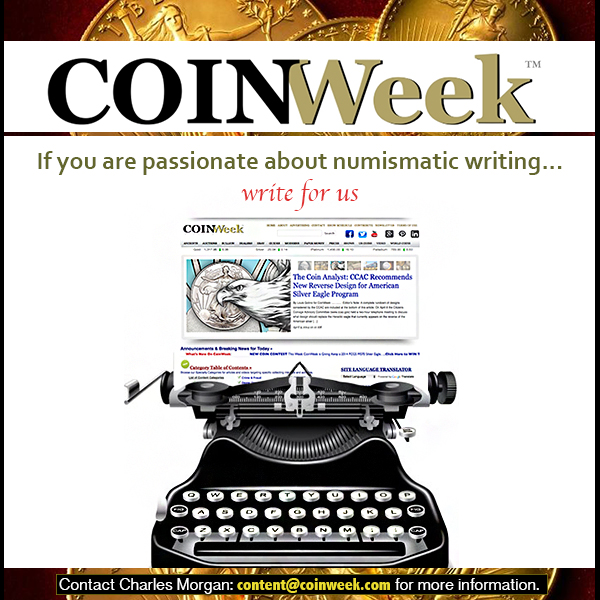
ROOSEVELT UNIVERSITY NUMISMATICS DIPLOMA
In previous E-Sylum items on the Roosevelt University (Chicago) Numismatics class offered during the 1965-1966 school year, I shared some of my fond remembrances. As I mentioned, I was the youngest student in the class (age 16), then a junior in high school (but already an amateur numismatist for several years, and co-founder and president of the Sullivan High School, Chicago, Coin Club). (A few months later I started a part-time job in the Stamp & Coin Department at Chandler's, 630 Davis St., Evanston, Ill., where I worked from 1966 to 1970 during high school and part of college.)
Anyway, at the end of the first semester all enrolled students received a "Record of Achievement" diploma, regardless of whether we had taken the 1 hour course for credit (I did not, as it required a paper to be submitted).
I recently came across my (now 48-year-old) diploma, which I have attached. As can be seen, the class was sponsored by Roosevelt's Division of Continuing Education and Extension, and it was awarded February 16, 1966. (I did not enroll for the second semester.)
Of particular interest are the five signatories. Original signatures are from Leo A. Young, President, Professional Numismatist Guild; Matt Rothert, President, American Numismatics Association; and A. M. Kagin, Numismatic Educational Program, and the stamped signatures are of Rolf A. Weil, President, Roosevelt University, and Lucy Ann Marx, Director, Division of Continuing Education and Extension. (Leo's and Art's signatures are in blue ink, Matt's in black.)
I don't think my certificate constitutes "exonumia", but for those who collect such things I doubt there are many other specimens still in existence!
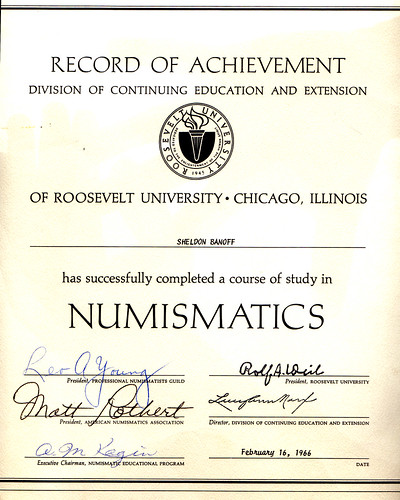
To read the earlier E-Sylum articles, see:
THE ROOSEVELT UNIVERSITY COURSE IN NUMISMATICS
(www.coinbooks.org/esylum_v13n34a17.html)
MORE ON THE ROOSEVELT UNIVERSITY COURSE IN NUMISMATICS
(www.coinbooks.org/esylum_v13n35a16.html)
JOHN BURNS ESTATE UPDATE: APRIL 20, 2014
Work continues apace on the estate of the late numismatic literature dealer John Burns. Executor Pat McBride reports that John's townhouse has finally been completely emptied and the keys will soon be returned to the landlord.
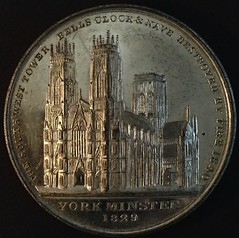 His personal and business stock numismatic literature has been assembled in his nearby storage units for sale by auction on May 9th.
Some of John's coins, tokens and medals will be displayed at the PAN Show in Monroeville PA May 8-10, 2014, but no plans for their disposal have been made yet.
His personal and business stock numismatic literature has been assembled in his nearby storage units for sale by auction on May 9th.
Some of John's coins, tokens and medals will be displayed at the PAN Show in Monroeville PA May 8-10, 2014, but no plans for their disposal have been made yet.
A memorial service/dinner/wake will be held for John at a restaurant in Monroeville PA Friday evening, May 9, 2014. To RSVP, contact Pat McBride at pancoins@gmail.com .
Following an earlier report on John's estate we heard from dealer Allen Berman who wondered if anyone had found among John's possessions a ceremonial axe, given to him in his position as "Royal Executioner and Lord High Character Assassin" in the Bermanian Guild of Numismatists.
Started on a lark by Berman (King Alanus I of Bermania), the little-known numismatic society hosts lighthearted gatherings of friends and associates united by their citizenship in the imaginary Kingdom of Bermania. Everyone has bestowed upon them a title and position, and John was delighted to play his role.
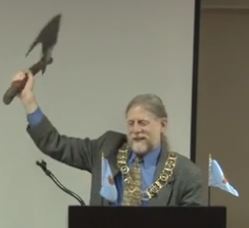 Luckily, John's axe and certificate were found and Pat McBride shipped them to Berman at the Chicago International Coin Fair.
In this CoinWeek video by David Lisot of a Bermanian gathering at the show, Berman recounts the tale of John's introduction to the group.
Luckily, John's axe and certificate were found and Pat McBride shipped them to Berman at the Chicago International Coin Fair.
In this CoinWeek video by David Lisot of a Bermanian gathering at the show, Berman recounts the tale of John's introduction to the group.
Noting that a moment of silence would not be John's way, he leads his subjects in a rousing "moment of boisterousness", waving the axe to shouts of Burns! Burns! Burns!
Nicely done - be sure to view the video online.
To view the complete video on CoinWeek, see: Bermanian Numismatic Tribute to John Burns. VIDEO: 4:57 (www.coinweek.com/video-news/new-videos/bermanian-numismatic-tribute-john-burns-video-457/)
To read the earlier E-Sylum article, see: UPDATE ON THE JOHN BURNS ESTATE (www.coinbooks.org/esylum_v17n10a08.html)
UNIQUE ÆTHELBERHT II SILVER PENNY TO BE SOLD
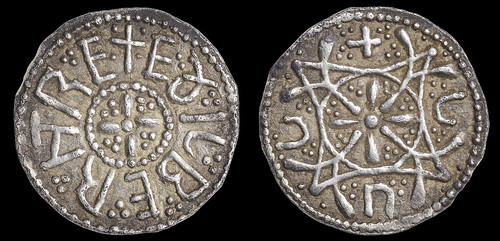
TO BE AUCTIONED PROVIDES A CLUE TO AN
EAST ANGLIAN ROYAL MURDER
The unique silver penny minted for Æthelberht II found by metal detectorist Darrin Simpson A unique Anglo-Saxon silver penny which provides a clue to the murder of a saintly East Anglian king by a neighbouring monarch has been found in a Sussex field by a metal detectorist. The 1,200 year-old coin minted during the reign of Æthelberht II will be auctioned at Dix Noonan Webb, the international coins and medals specialists, in London on 11 June 2014, when it is expected to fetch £15,000 to £20,000.
Darrin Simpson, a 48 year-old pest control specialist from Eastbourne, Sussex, was hurrying to shelter from a hailstorm in early March when he picked up a signal on his detector. Despite the appalling weather he stopped, dug down 6-8 inches and found the penny which has been identified by experts as the only one of its type ever discovered.
Mr Simpson, who has been a metal detectorist for 12 years, had been working his way across the unidentified site in Sussex for about an hour when he was caught in the hailstorm. As he moved quickly, planning to take shelter under some trees, he got a signal similar to others he had picked up that day. As they had all turned out to be Second World War era .303 bullet cases, he was not optimistic as he stopped to dig.
“I thought it was a Saxon coin, the first one I had found, and I was very happy about that,” said Mr Simpson. It was not until he contacted the Early Medieval Corpus of Coin Finds at the Fitzwilliam Museum in Cambridge that he realised the full importance of his discovery. “It was a bit of a shock really, I couldn’t sleep for two nights after it was identified,” he said. “The condition is really good. This is a unique coin. I doubt if I will ever find anything better.”
The coin is only the fourth ever found from the reign of Æthelberht II, a shadowy figure who ruled East Anglia in the late 8th-century. The other three are all in museums and have a different design. The coin found by Mr Simpson is the first to have Æthelberht’s name and the title REX on the same side.
“This new discovery is an important and unexpected addition to the numismatic history of 8th century England,” said Christopher Webb, head of the coins department at Dix Noonan Webb.
Little is known about Æthelberht II’s reign but stories about his piety and his gruesome end ordered by Offa, king of neighbouring Mercia, have survived down the centuries. His reign over the kingdom of East Anglia is thought to have begun in 779. Fifteen years later in 794 he reluctantly agreed to marry Eadburh, Offa’s daughter, and set off to visit her at the Mercian king’s villa at Sutton Walls in Herefordshire.
In a scene worthy of the television series Game of Thrones, Offa’s queen Cynethryth persuaded her husband to have their guest killed and Æthelberht was seized, bound and beheaded. Even in those brutal times, the murder of one king by another was rare.
According to medieval legend, Æthelberht’s severed head later fell off a cart and, after being found in a ditch, restored a blind man’s sight. The dead king was declared a saint and became the focus of a religious cult in East Anglia. Many parish churches in Norfolk and Suffolk are still dedicated to him Medieval brass depicting the headless St Ethelbert with Christ stained glass in St Ethelbert’s Æthelberht II Church, Alby, Norfolk
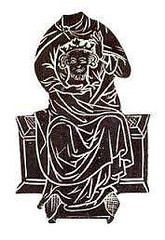
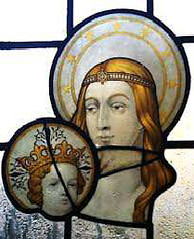
The coin to be auctioned at Dix Noonan Webb may have been one of the reasons for Æthelberht’s terrible end. The East Anglian king is believed to have struck the other three known coins from his reign with the approval of his much more powerful neighbour Offa. However the newly-discovered penny looks like an act of defiance by the increasingly ambitious Æthelberht.
The fact that Æthelberht’s name and the title REX (King) appear on the same side of the coin may have demonstrated a degree of independence that was simply too much for Offa and Cynethryth to bear and they decided to kill him. How this penny came to be in a Sussex field will never be known but its discovery by Mr Simpson provides us with a possible motive for a 1,200 year-old Anglo-Saxon royal murder.
For more information, see: www.dnw.co.uk

SOME RECENT COIN DESIGNS: APRIL 20, 2014
France 10 Euro Rooster Coin
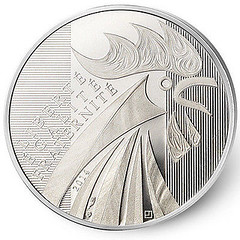
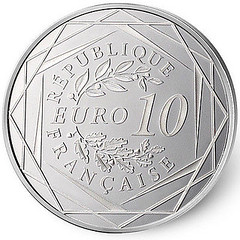
Finland 10 Euro Literacy Coin
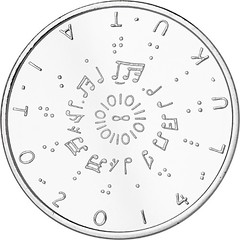
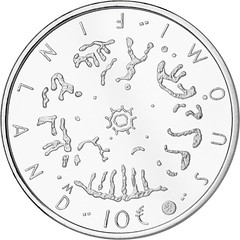
2015 Lithuanian 2 Euros

To read the complete article, see: The 2015 Lithuanian euro coin samples have been minted (www.lb.lt/the_2015_lithuanian_euro_coin_samples_have_been_minted_1)
Italy: Gioachino Rossini 10 Euro Silver Coin
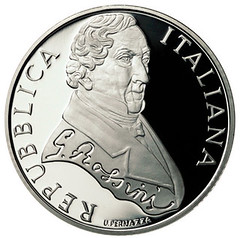
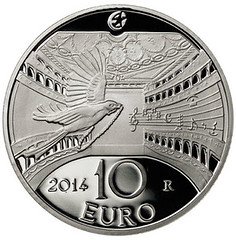
I really like this one - it's a beautiful coin. -Editor
To read the complete article, see: Italy: Gioachino Rossini 10 Euro Silver Coin (world.mintnewsblog.com/2014/04/italy-gioachino-rossini-10-euro-silver-coin/)
WEB SITE: MEDALLIC ART COLLECTOR
The focus of this site is definitely on 20th Century and current American art medals. There are already many sites that focus on famous European medalists, but there are surprisingly few sites that deal with their American counterparts. Many American sculptors are recognized for their contributions to the decorative arts or to architectural sculpture, yet their efforts as medalists are not similarly appreciated, therefore this website. Foreign sculptors are not excluded though: any foreign artist who was associated with an American medal series can also be represented here. Interesting modern art medal sculptors from all over the world can also find a home here.
This effort just got under way and the gaps in content are large. I am adding both content and site functionality as fast as I can. Visit again a few weeks from now and see whether a click on a medal or a sculptor produces additional information. I want to make this site useful, not just to me but to the wider collectors' community.
St. George and the Dragon (1986)
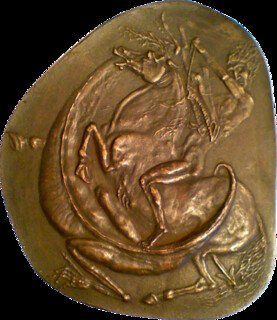 This cast bronze medal reworks the ancient legend of George and the Maiden. The old story tells of the inhabitants of Silene, who were forced to regularly feed a maiden to a dragon that had made its lair nearby. When it was the princess' turn to be sacrificed, George went to rescue her from this tragic fate.
This cast bronze medal reworks the ancient legend of George and the Maiden. The old story tells of the inhabitants of Silene, who were forced to regularly feed a maiden to a dragon that had made its lair nearby. When it was the princess' turn to be sacrificed, George went to rescue her from this tragic fate.
In a feminist treatment of the subject, relevant to the context of the 1980s, Moss shows George absorbed in his fight with the dragon, while the maiden, tired of waiting, decides to rescue herself. No longer the submissive woman of the traditional readings of the story, she cuts her hair to draw strength and establish her independence.
This medal exists in two different versions. The medal depicted here and the medal at the Victoria and Albert Museum differ in the imagery on the reverse.
A copy of this medal can be found at the Victoria and Albert Museum.
Wasichu (1991)
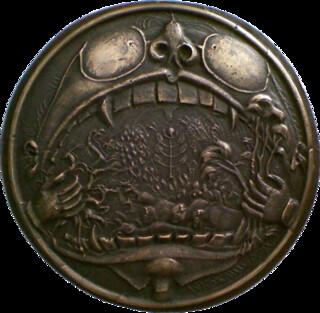 The obverse of Wasichu shows a bespectacled and tie-wearing monster, almost totally reduced to its gaping maw, swallowing nature in all its forms. The reverse depicts an industrialized wasteland with the discarded trappings of our modern life. Immense buttocks that loom over the landscape discharge a fecal stream of waste that rains down from above and threatens to cover everything.
The obverse of Wasichu shows a bespectacled and tie-wearing monster, almost totally reduced to its gaping maw, swallowing nature in all its forms. The reverse depicts an industrialized wasteland with the discarded trappings of our modern life. Immense buttocks that loom over the landscape discharge a fecal stream of waste that rains down from above and threatens to cover everything.
This medal reflects Moss' growing concern about pollution and the consequences of our industrialized way of life
Mamoo (?)

To view the complete page, see: Nicola d'Alton Moss (medallicartcollector.com/nicola-dalton-moss_biography.html)
ROCHESTER PUBLIC MARKET ADOPTS WOODEN TOKENS
The Rochester Public Market's EBT Token program, established to bring healthier options to people on food stamps, has grown into the largest of its kind in the country.
Now in its fifth year, the program is giving thousands of SNAP (Supplemental Nutrition Assistance Program) recipients the purchasing power to eat healthy, fresh and local by using market tokens. The wooden coins are purchased with a food stamp card at the market office and is now accepted as currency by 120 vendors at the market year-round.
That brings the chance to purchase fruits, vegetables, meat, fish, cheese, baked goods, honey — even empanadas. Often, those on food stamps are forced to settle for the packaged convenience foods that are lower in price, but also lower in nutritional value, than fruits, vegetables and less processed cheese and meat.
Families gain access to healthier food while local farmers, in turn, gain more customers.
The token program is sponsored by the Friends of the Rochester Public Market, whose website describes the concept as "a simple solution to the complex problem of access to healthy and affordable food."
The program began with a card-based system, but swiping the cards at booths had glitches. The current system is deliberately low-tech — and effective. The EBT Token program has surpassed half a million dollars in annual sales. In 2013, 8,000 food stamp customers purchased $502,300 of fresh fruit and vegetables, and other healthy affordable foods.
As a result of the token program, 70 percent of participants report eating "a lot more" fruits and vegetables. They also report purchasing more fresh fruit for their children. And because the market's low prices help them stretch their food dollars, program participants are buying more and better quality foods, especially fresh produce. Sixty percent of participants say they shop at the market more frequently due to the tokens.
Nick's fellow club member Bill Coe adds:
I mentioned the article about the wooden nickels at last Thursday's meeting. A few members were familiar with them. They are available only to SNAP participants. However, several thought if one were to go to the open-air market one could obtain them by offering face value ($1 & $5) to either the SNAP buyer or to the merchant who honors them. No information on who ordered them or from whom they were obtained. There are several wooden nickel makers around the country.
To read the complete article, see:
Wooden tokens open Rochester Public Market to poor
(www.democratandchronicle.com/story/news/2014/04/16/
wooden-tokens-open-rochester-public
-market-poor/7799709/)
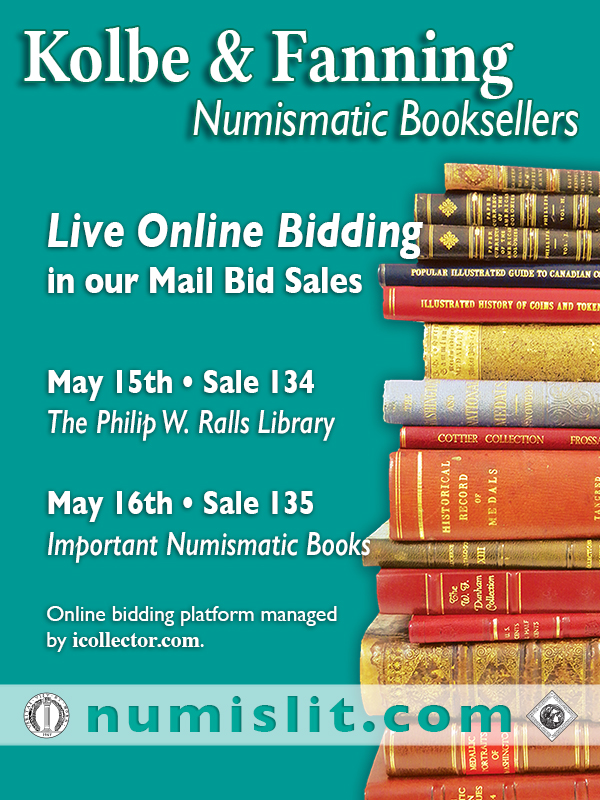
AN UNCLASSIFIED PEEK INSIDE FORT KNOX
 From the outside, the Depository appears to be a concrete, depression-era structure–nothing special, unlike the Fort Knox of Hollywood fame. But, it IS well protected. There are concentric rings of defenses starting with the two-story vault, itself. The vault is small, less than 4000 square feet, and two stories high. Its walls are two feet thick and constructed of concrete-encased steel plates, steel I-beams, and steel cylinders laced with hoop bands. The vault walls and roof are separated from the Depository’s outer walls and roof, which are constructed of granite-lined concrete. The vault door is blast-, drill-, and torch-proof, 21 inches thick, and weighs in at more than 20 tons. It is set on a 100-hour time clock and is rarely opened.
From the outside, the Depository appears to be a concrete, depression-era structure–nothing special, unlike the Fort Knox of Hollywood fame. But, it IS well protected. There are concentric rings of defenses starting with the two-story vault, itself. The vault is small, less than 4000 square feet, and two stories high. Its walls are two feet thick and constructed of concrete-encased steel plates, steel I-beams, and steel cylinders laced with hoop bands. The vault walls and roof are separated from the Depository’s outer walls and roof, which are constructed of granite-lined concrete. The vault door is blast-, drill-, and torch-proof, 21 inches thick, and weighs in at more than 20 tons. It is set on a 100-hour time clock and is rarely opened.
Four armored guard boxes stand at each corner of the building and armored sentry boxes flank the entrance gate. The facility has stand-alone emergency power, water and other systems on site. The next ring of protection is the heavily armed and highly profession members of the United States Mint Police Force who can engage intruders from inside the fortress to beyond the outer steel fence. Between the walls of the Depository and the outer perimeter lie rings of razor wire and mine fields, monitored by high-resolution, night-vision video cameras and microphones.
The Depository sits on the Fort Knox Army post at the corner of Bullion Blvd. and Gold Vault Road (no kidding). When I was director, the post offered additional protection in the form of the 194th Armored Brigade, helicopter gunships, artillery, and as I recall, 25,000 soldiers. I know that Fort Knox has gone through significant downsizing over the past decade, so I’m uncertain how much of this firepower is available today.
During my visit, I asked if anyone had been crazy enough to try to penetrate these awesome defenses. I was told that on one or two occasions, an inebriated soldier, looking for a shortcut back to base from a local bar and not knowing where he was, had attempted to climb the outer fence. You can imagine the sobering effect the floodlights, alarms, and booming speakers would have had on the unfortunate fellow.
Today, Fort Knox holds about 4600 metric tons of gold worth close to $200 billion dollars. This represents 2.5% of all the gold ever refined—as in ever in the course of human history. During World War II, the Depository held more than four times its current holdings.
But gold might not have been the most valuable asset held by the Depository. Over the years, Fort Knox has protected copies of the Gutenberg Bible, the Magna Carta, the Declaration of Independence, the U.S. Constitution, and the Gettysburg Address, among other priceless artifacts. On a grimmer note, during the Cold War, morphine and opium were stored at the Depository in case they were need in huge quantities after a nuclear exchange with the Soviet Union.
To read the complete article, see: The Real Diehl: An Unclassified Peek Inside Fort Knox (www.coinweek.com/bullion-report/the-real-diehl-an-unclassified-peek-inside-fort-knox/)
IRON AGE NORFOLK WOLF COINS UNCOVERED

An "unusual" hoard of 44 Norfolk wolf coins produced in the latter stages of the 1st Century and found in south Norfolk have been declared treasure.
The Iron Age coins, about the size of a thick modern penny, were minted by the Iceni tribe whose territories covered much of East Anglia.
Museum finds officer Adrian Marsden said the coins probably belonged to "a member of tribal hierarchy".
The Norwich Castle Museum hopes to acquire them for its collection.
"This number of coins is unusual," Mr Marsden said. "We did have a hoard of 82 from north-west Norfolk in the 1980s but 44 is certainly sizeable and more may turn up.
"Although these aren't the bright yellow gold of earlier Norfolk wolf staters (coins) they would have represented a fair amount of wealth... the person who buried these would have been someone of account.
"These coins get debased over time, so you get bright yellow buttery gold ones, then years later ones that are more coppery with a bit of silver," he added.
The Norfolk wolf coins were among a number of treasure items found by metal-detecting enthusiasts, featured at the Norfolk Coroner's Court.
To read the complete article, see: Norfolk wolf coins unearthed in treasure find (www.bbc.com/news/uk-england-norfolk-26947305)

EXHIBIT: CURIOSITIES FROM THE BANK OF ENGLAND VAULTS
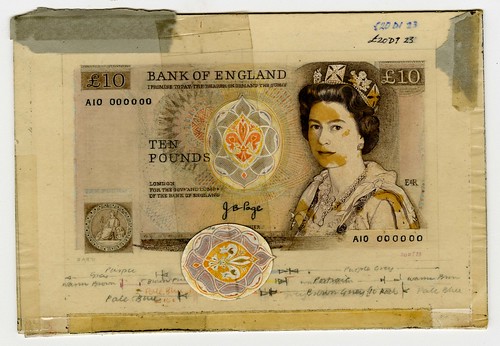
Pasteup of Nightingale £10 note
The Bank of England Museum's latest exhibition offers a look at some fascinating items from its archives, including bank note test prints and sketches by designer Harry Ecclestone.
Curiosities from the Vaults: A Bank Miscellany is open until July 11 and features items collected by the bank since it was founded in 1694. Alongside paintings, rare ceramics and an 18th century sculpture of its emblem are a series of illustrations and tests for notes created by Ecclestone, who was the bank's first in-house designer.
Ecclestone worked for the bank for 25 years and was responsible for designing the 'D' series of notes, issued in 1970. A president of the Royal Society of Painter-Etchers and Engravers, he was awarded an OBE for his services in 1979, and he died in 2010.
Other items in the collection include high value notes signed by Nelson Mandela and George Eliot, a ballot box designed by architect John Soane and a leather trunk used for 'carrying gold across deserts', which is thought to have belonged to army officer TE Lawrence (Lawrence of Arabia). Lawrence was offered a job by the bank in 1934, a record of which is also on display.
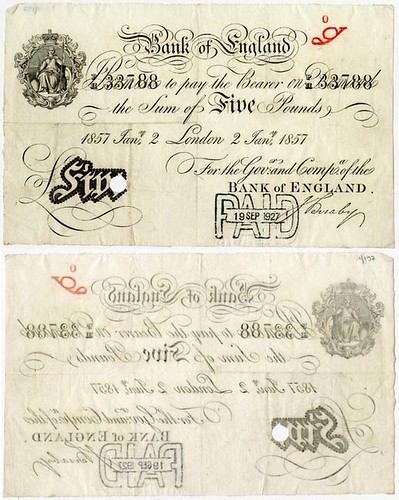
Britannia £5 note designed by Irish artist Daniel Maclise
To read the complete article, see: The art of bank note design (www.creativereview.co.uk/cr-blog/2014/april/bank-of-england-museum)
THE 2014 ROYAL MAUNDY CEREMONY
 This year, on Maundy Thursday, Her Majesty The Queen will travel to Blackburn Cathedral for a Maundy Ceremony during which, among many other traditions, she will hand out Maundy Money. The tradition of the Monarch giving money to the needy on Maundy Thursday dates back 700 years, the tradition eventually becoming known as the Royal Maundy. Today’s recipients are usually people over the age of 70, chosen not because they are needy but for service to their churches and communities.
This year, on Maundy Thursday, Her Majesty The Queen will travel to Blackburn Cathedral for a Maundy Ceremony during which, among many other traditions, she will hand out Maundy Money. The tradition of the Monarch giving money to the needy on Maundy Thursday dates back 700 years, the tradition eventually becoming known as the Royal Maundy. Today’s recipients are usually people over the age of 70, chosen not because they are needy but for service to their churches and communities.
The number of people who receive Maundy Money has evolved over the years, and now equals the number of years of the monarch’s age, with the same number of men as women nominated.
So, in 2014 88 men and 88 women will receive these incredibly special coins. They will be given a white purse containing 88p in Maundy coins (one for every year of the Monarch’s age) and a red purse containing the 2014 commemorative £5 and 50p coins – both of which, unlike Maundy Money, are available to purchase.
The money itself has changed little since the 17th century, with only the face value of the coins being increased from old to new pence due to decimalisation in 1971. Four portraits of The Queen have appeared on our circulating coins but Maundy coins still bear the portrait of The Queen used for the first coins of her reign in 1953.
In the run-up to the event, this year’s lucky Blackburn guests recently attended a “Maundy Lecture” in the cathedral, which is effectively a rehearsal to prepare them for the service on 17th April. After the ceremony The Queen and Prince Philip will attend a Reception at Blackburn Rovers Football Club to meet all those involved.
It is said that The Queen takes quite an informal approach at this event, and many people find it a very emotional experience. Stories abound of exchanges with Her Majesty, one of which is the tale of a recipient who gave her a jar of home-made marmalade in return for the Maundy Money.
Since she came to the throne in 1952, The Queen has missed the Maundy Money service on only four occasions and the 2014 ceremony will be the 59th time she has performed the historic ceremony.
MAUNDY MONEY FACT: Henry IV was the first monarch to decree that the number of Maundy recipients should equal the years of the Monarch’s age, although the practice began at least as far back as 1363 when the then 50-year-old Edward III gave gifts to 50 poor men.
To read the complete article, see: Maundy Money – A rare Monetary gift from the Monarch - See more at: http://blog.royalmint.com/maundy-money-history-2014/#sthash.CRlSWXxc.dpuf (blog.royalmint.com/maundy-money-history-2014/)
THE BOOK BAZARRE
BRITISH MUSEUM VIKING COIN EXHIBITION
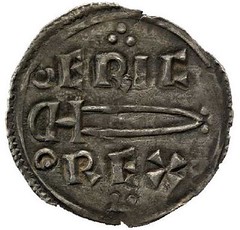 Coins feature in a number of places in the exhibition Vikings:
life and legend. Coins minted by Viking kings such as Eirik
Bloodaxe of Northumbria, Harald Bluetooth of Denmark and
Cnut the Great are, of course, included and help to tell a
story of increasing national unity, economic change and
processes of Christianisation.
Coins feature in a number of places in the exhibition Vikings:
life and legend. Coins minted by Viking kings such as Eirik
Bloodaxe of Northumbria, Harald Bluetooth of Denmark and
Cnut the Great are, of course, included and help to tell a
story of increasing national unity, economic change and
processes of Christianisation.
More unusual is a rare glimpse of two coins minted by Vladimir the Great of Kiev, the Rus prince who claimed descent from Scandinavian Vikings. The exhibition also includes many of Islamic coins – found in hoards (such as the British Museum’s own Vale of York hoard) or converted into jewellery - that bear witness to the activity of Viking traders in Eastern Europe and central Asia.
The importation of silver coins from the Islamic Caliphate had a transformative effect on Viking-Age silver economies. Equally striking is the sight of large numbers of freshly minted late Anglo-Saxon coins in the Tyskegård hoard (National Museum of Denmark) – a collection of wealth that demonstrates that the Anglo-Saxon state was as rich a source of tribute as the documentary sources suggest.
For more information on the Money and Medals Network, see: www.moneyandmedals.org.uk/
NUMISMATIC EXHIBITS ON WORLD WAR I CENTENARY
An interview with the curators of two new WWI numismatic exhibitions Shailendra Bhandare, Assistant Keeper, Heberden Coin Room, Ashmolean Museum and Tom Hockenhull, Curator of Modern Money, British Museum
Can you give a broad overview of your exhibition and how it fits (or doesn't) into how your museum is approaching WWI?
TH. As part of the centenary commemorations for the outbreak of the First World War, the British Museum is examining the German experience through a display of medals made by artists who lived and worked in Germany during the war. Emerging art movements such as expressionism were adapted to the form of the medal, whilst artists also looked to Germany’s past, blending medieval and Renaissance styles. Expressive and sometimes provocative, they document the realities of the conflict from both an historical and an emotional perspective. 2014 also marks the 25th anniversary of the fall of the Berlin Wall and the 300th anniversary of the Hanoverian succession, and the display coincides with a whole year of Germany-related events and exhibitions at the British Museum.
SB. The special exhibition to commemorate the First World War in the ‘Money’ Gallery at the Ashmolean covers the theme in three components – a case with objects and two graphic panels.
What are the themes around which the gallery display is structured?
TH. Occupying ten cases in the Coins and Medals changing displays gallery (Room 69a), the exhibition groups the medals not chronologically but by such themes as war on land, war at sea and war at home. This latter section features some of the most poignant works, including Ludwig Gies’ Refugees.
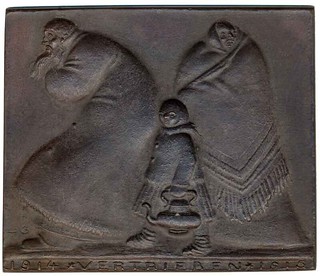
Refugees by Ludwig Gies
© Trustees of the British Museum
Three hunched figures, one clutching a kettle which is perhaps their sole remaining possession, flee the Russian invasion of East Prussia in September 1914. A number of German artists revived the medieval Dance of Death motif, in which skeletal figures indiscriminately drag the living to their demise. It was decided to make this a major theme of the exhibition and several medals, such as Hans Lindl’s War on Land and Sea, were chosen with this in mind.
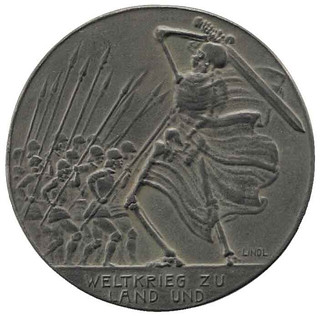
War on Land and Sea by Hans Lindl
© Trustees of the British Museum
Lindl’s work mixes medieval and modern themes by showing German soldiers dressed in old fashioned armour. Their unrealistically long lances appear vulnerable against the huge sword-wielding figure of Death. Meanwhile, the central case in the display, designed to catch the eye of the passing visitor, features a German stahlhelm (steel helmet) on loan alongside a medal showing a German soldier wearing a similar helmet, commemorating the Battle of the Somme.

Somme Medal by A.Galambos
© Trustees of the British Museum
The reverse of the medal reads ‘To die for the fatherland is a sweet thing and becoming’, quoting a line from the Roman poet Horace. It reminds the visitor that these medals weren’t mere abstract musings about the horrors of war. They were made by people who lived through war and its consequences: indeed, many artists were active combatants.
SB. The case will have three main display focuses which will be showcased through medals – commemorative as well as campaign. The focuses will be ‘Commemorating Events’, ‘Commemorating People’ and ‘Commemorating Valour’ which will be shown through objects in the case; the graphic panels will illustrate ‘The Art of the Medals’ and ‘Emergency Money’. It is thought to show the money-items only through graphic enlargements on the panels because of their rather small and insignificant size which will prove difficult to engage audience if they are shown in the case.
3) What objects have you used in the display. Were there things you would have liked to include and didn't, and why?
TH. The British Museum has a collection of German art medals totalling almost five hundred about the war. Owing to the strength of the collection, narrowing the list down to a selection of 40-50 objects was very challenging. The final selection was chosen to satisfy two objectives: firstly, that all the medals on display should be visually arresting, and secondly that they should be able to illustrate an historical narrative about the war.
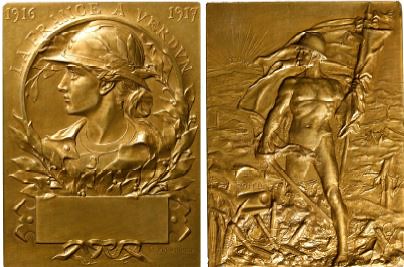
Verdun medal by Georges-Henri Prud'homme
© Ashmolean Museum
SB. The medals ‘commemorating events’ will include those struck to commemorate the Assassination of Archduke Ferdinand, Aerial Bombardment of London, the Sinking of Lusitania, the War Theatres in Africa, the Armistice and salient battles such as Ypres, Verdun and Jutland. ‘Commemorating People’ will have the German-Austro- Hungary-Turkey leaders, Statesmen like Lloyd George and Woodrow Wilson and military generals like Kitchener, Joffre, Zeppelin and Hindenburg. Military medals and decorations from England, France, Germany and Austro-Hungary will showcase ‘commemorating valour’. One of the graphic panels will bring out the artistic aspects of the medals; the other will show interesting monetary objects like encased postage stamps used as money, prisoner-of-war tokens, field canteen tokens and emergency money forms such as ‘kriegsgeld’ and paper coupons.
4) Why is it important to mark the start of WWI in museums, particularly in archaeology and art museums?
TH. It is important for museums to display the material culture of the war so that one can begin to appreciate the enormity of the losses. 11 million Germans went to war and 1.8 million never returned home. Merely relaying these statistics without supporting material would not adequately express the scale of the destruction, or the way in which it ignited the imaginations of those who lived through it.
SB. The emphasis of the exhibition is on commemorating the
War as a watershed event that changed global history and was stark and full of awe in its detail, not to glorify the victories or showcase ‘triumphalism’ in any way. The choice of the material reflects this and it also meant that some objects, particularly those like the propagandist medals had to be kept out. Included in this category are some racist and nasty medallic renderings by Karl Goetz which would not be ‘politically correct’ in today’s context for the sentiments they evoke.
5) How do your respective numismatic collections lend themselves to tackling exhibition subjects of this kind? Where are they strong or weak and who's stories do they tell?
TH. The British Museum’s collection of First World War medals is fairly representative, and it contrasts with the limited output by allied artists in comparison with German artists. Indeed, this was even noted during the war, prompting Sir Arthur Evans (archaeologist, British Museum Trustee and President of the Royal Numismatic Society) to offer a prize for the best medal commemorating a naval victory at Jutland in 1916.
SB. The coin collection at the Ashmolean is not particularly great in the 20th century realm - primarily because as a University teaching collection (as against a 'national collection') it is built around an active interest in History beyond the 'contemporary' period. But our collection of medals is pretty good and covers a wide range of interests, events and purposes. Some of the material has a local 'Oxford' flavour in being gifted by local people who were or weren't associated with the University.
For more information on the Money and Medals Network, see: www.moneyandmedals.org.uk/

MORE ON THE VACHERON CONSTANTIN FABERGE EGG
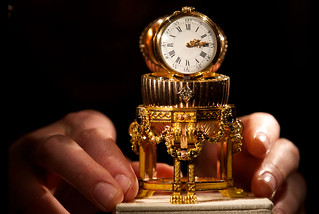 One of the missing Imperial Fabergé Easter Eggs made for the Russian Royal family will be on public view at Court Jewellers Wartski in Mayfair in the run up to Easter. The magnificent Third Imperial Fabergé Easter Egg will be on view for four days only from the 14th April 2014 and is unlikely to be seen again in public for a long time.
One of the missing Imperial Fabergé Easter Eggs made for the Russian Royal family will be on public view at Court Jewellers Wartski in Mayfair in the run up to Easter. The magnificent Third Imperial Fabergé Easter Egg will be on view for four days only from the 14th April 2014 and is unlikely to be seen again in public for a long time.
This Fabergé egg, which is beautifully crafted and contains a Vacheron Constantin watch inside, is sitting on an elaborate, jewelled gold stand and measures 8.2 cm in height in total. It was given by Alexander III Emperor and Autocrat of all the Russians to his wife Empress Maria Feodorovna for Easter 1887.
Easter is the most important of all Russian Orthodox festivals and it's a long established tradition to exchange Easter eggs. Carl Fabergé, goldsmith to the Tsars, created the lavish Imperial Easter eggs for both Alexander III and Nicholas II from 1885 to 1916. The Eggs are his most prized creations and have become bywords of luxury and craftsmanship.
This egg was last seen in public over 112 years ago, when it was shown in the Von Dervis Mansion exhibition of the Russian Imperial Family's Fabergé collection in St. Petersburg in March 1902. In the turmoil of the Russian revolution the Bolsheviks confiscated the Egg from the Empress. It was last recorded in Moscow in 1922 when the Soviets decided to sell it as part of their policy of turning ‘Treasures into Tractors’. Its fate after this point was unknown and it is was feared it could have been melted for its gold and lost forever.
It was only in 2011 that Fabergé researchers discovered that the Third Imperial Egg survived the revolution, when it was discovered in an old Parke-Bernet catalogue. Its provenance had been unknown and so it was sold at auction on Madison Avenue, New York on 7th March 1964 as a 'Gold watch in egg form case' for $2,450 (£875 at the time). This discovery started a worldwide race to discover the whereabouts of the egg, which was now worth tens of millions of dollars.
In the meantime the egg was bought in the Mid-West of America at a bric-a-brac market. The buyer lived a modest live and tried to make extra money by buying gold and selling it for its scrap metal value. When he spotted the egg, he thought he could make an easy $500, although they had to pay $14,000 for its scrap metal value. But what had worked on many occasions, did not work this time. He had overestimated its worth and couldn’t sell it. No one spotted its potential and luckily no one offered more than the owner had paid for it, hence it was saved from the melting pot. The egg has several scratches on it where the metal was tested for its gold content.
The egg became a financial burden to its unknowing owner. One evening in despair the owner tapped 'Egg' and 'Vacheron Constantin' into Google and a Telegraph article regarding the egg's survival appeared quoting Kieran McCarthy, director of Wartski, the London based, Royal Warrant holding experts on the work of Carl Fabergé.
Recognising his egg in the article the owner was unable to sleep for days. He got on a plane to London to find Kieran and to show him images of the egg. Kieran was left speechless by the images and was almost certain the lost egg had been found, but to confirm its identity and ensure it was not a very clever fake, he travelled to the US. When he arrived in a small town in the Mid-West, he was shown into the kitchen of the owner’s home and presented with the egg, which was slightly smaller than the large cupcake positioned next to it. After an examination he confirmed that it was indeed the lost Imperial treasure. It had travelled from the hands of an Empress in the grandeur of Imperial St. Petersburg to a scrap metal dealer in modern day America.
Wartski acquired the egg for a private collector, making the finder an art historical lottery winner, receiving multiple millions of dollars per centimetre of egg. The collector has generously allowed the egg to be displayed in London where it will be on view for only four days in a specially designed exhibition at Wartski.
To read the complete article, see: Lost treasure found after almost 100 years: Wartski exhibits missing Fabergé egg (artdaily.com/news/69426/Lost-treasure-found-after-almost-100-years--Wartski-exhibits-missing-Faberg--egg#.U03cEPmcJRQ)
To read the earlier E-Sylum article, see: IMPERIAL FABERGE EGG FOUND AT 'FLEA MARKET' (www.coinbooks.org/esylum_v17n12a29.html)
THE WORLD'S MOST BEAUTIFUL BOOKSHOPS

Livraria Lello book shop, Porto, Portugal

El Ateneo Bookshop, Buenos Aires, Argentina
To read the complete article, see: Ten of the world’s most beautiful bookshops (www.bbc.com/culture/story/20140327-worlds-most-beautiful-bookshops)
ATMS THAT FIGHT BACK
Fancy an Automated Teller Machine (ATM) that punches the burglar in the nose if he tries to break it open?
Well, not a punch exactly, but ATMs would soon be armed with a mechanism that would spray hot foam in the face of the attacker if he tries to force it open.
Researchers at ETH University in Zurich have developed a special film that triggers an intense reaction when destroyed.
“This could be used anywhere you find things that shouldn’t be touched,” said Wendelin Jan Stark, a professor at ETH’s department of chemistry and applied biosciences.
Stark and his team developed a self-defending surface composed of several sandwich-like layers of plastic. If the surface is damaged, hot foam is sprayed in the face of the attacker.
The researchers used plastic films with a honeycomb structure for their self-defending surface. The hollow spaces are separately filled with two chemicals: hydrogen peroxide or manganese dioxide.
The two separate films are then stuck on top of each another. A layer of clear lacquer separates the two films filled with the different chemicals. When subjected to an impact, the interlayer is destroyed, causing the hydrogen peroxide and manganese dioxide to mix.
This triggers a violent reaction that produces water vapour, oxygen and heat. The temperature of the foam reaches 80 degrees.
The newly developed film may be particularly well suited to protecting ATMs or cash transports, said the researchers.
To read the complete article, see: Coming soon, ATMs that retaliate when they are attacked (www.indiatvnews.com/business/india/latest-news-coming-atms-that-retaliate-when-they-are-attacked-11270.html)
 The idea originates from a beetle that uses a gas explosion to fend off attackers.
The idea originates from a beetle that uses a gas explosion to fend off attackers.
Its head and pronotum are usually rusty red, and its abdomen blue or shiny green: the bombardier beetle is approximately one centimetre long and common to Central Europe. At first glance, it appears harmless, but it possesses what is surely the most aggressive chemical defence system in nature. When threatened, the bombardier beetle releases a caustic spray, accompanied by a popping sound. This spray can kill ants or scare off frogs. The beetle produces the explosive agent itself when needed. Two separately stored chemicals are mixed in a reaction chamber in the beetle's abdomen. An explosion is triggered with the help of catalytic enzymes.
“When you see how elegantly nature solves problems, you realise how deadlocked the world of technology often is,” says Wendelin Jan Stark, a professor from the ETH Department of Chemistry and Applied Biosciences.
To read the complete article, see: The ATM strikes back (www.ethz.ch/en/news-and-events/eth-news/news/2014/04/der-bancomat-schlaegt-zurueck.html)
FEATURED WEB SITE: MONEY & MEDALS NETWORK
This week's Featured Web Site is the Money & Medals Network.The Network is funded by Arts Council England and the British Museum's Partnership UK programme which receives funding from the Vivmar Foundation. A number of key partner institutions are affiliated with the Network.
It has five main aims:
- Act as an information exchange for curators within the UK whose collections include coins, medals and other objects relating to monetary and economic history and numismatics
- Provide information on best practice, new research and news items relating to the understanding, care and public access of those collections
- Encourage and facilitate collaborative ventures between the curators of those collections and to nurture links between those curators and individuals outside museums with an interest in related subject areas
- Make the broad case for the potential of those collections and the importance of numismatic expertise for bringing them effectively to a wide audience and;
- Work to identify new and exciting ways in which those collections can be presented to the public.

www.moneyandmedals.org.uk
